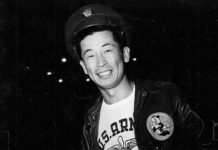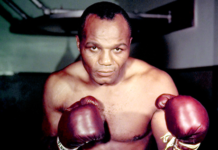ROLLING STONE; By Amelia McDonell-Parry; July 02, 2018;
A 40-member team led by former FBI investigators is claiming to have proof of the real identity of D.B. Cooper, the notorious airplane hijacker who has remained at large since he parachuted out of a Seattle-bound plane with $200,000 in November 1971.
According to filmmaker and author Thomas J. Colbert – who organized, launched and funded the volunteer sleuths for the last seven years – the real Cooper is a 74-year-old Vietnam veteran named Robert W. Rackstraw Sr. And the proof is hidden in a series of letters allegedly written by Cooper in the months after the hijacking and his disappearance.
Rackstraw – a former Special Forces-trained paratrooper, explosives expert and pilot with a documented 22 identities – was once a person of interest in the case, but was eliminated as a suspect by the FBI in 1979. His elimination was controversial amongst the investigating agents on his case, and he remained, for many, the most viable suspect in what still is the only unsolved case of air piracy in the United States. In 2016, the FBI announced they were closing their investigation.
“This has been a cover up, they’re stonewalling,” Colbert told the Seattle Post-Intelligencer.
He believes that the FBI protected Rackstraw because he was involved in numerous classified units during the war and, multiple sources claim, later worked for the CIA. (A rep for FBI’s Seattle field office did not immediately return a request for comment)
Colbert and his team say D.B. Cooper’s identity has been in the FBI’s file all along, encrypted into a series of letters sent to various newspapers in the months after the hijacking.
While the first four letters had been made public, the FBI kept a fifth and sixth letter under wraps. After a half-year court battle, Colbert and his wife, Dawna, successfully sued for the Cooper case file under the Freedom of Information Act (FOIA). Colbert claims all six letters contain messages in Army coding that point directly at Rackstraw.
The Seattle Post-Intelligencer contacted Rackstraw – who is currently living in San Diego – last November. They wrote that he did not confirm or deny anything, telling the reporter to “verify Colbert’s facts.”
But last February in Washington, D.C., a Courthouse News reporter pressed Rackstraw on the same matter. For the first time, the ex-con was unequivocal in his telephone call: “There’s no denial whatsoever, my dear.”
Rick Sherwood – a former member of the Army Security Agency, which decrypted signals during the Vietnam War – unmasked the buried codes. Rackstraw served under Sherwood in two classified units, and Sherwood was familiar with his writing style, having deciphered some of his earlier messages. When he saw the fifth and sixth typewritten letters, he immediately thought the “odd letter and number combinations” were indicative of the type of encryptions that Rackstraw would send.
According to the SeattlePI, Sherwood spent two weeks working on the solution, which allegedly referred to three specialized army programs that just one soldier had served in. “He was the only man in the whole American Army with those three units,” Colbert told Seattle PI. “That’s why we know it’s (Robert) Rackstraw.”
In February, Colbert and his team briefly made headlines when they released Sherwood’s analysis of the fifth letter and officially fingered Rackstraw as D.B. Cooper. But the sixth letter, sent to Portland’s Oregonian newspaper in March 1972, turned out to be even more damning – “the icing on the cake,” as Colbert put it.
“I read it two or three times and said, ‘This is Rackstraw, this is what he does,’” Sherwood told The New York Daily News. “I noticed he kept on repeating words in his sentences and thought he had a code in there somewhere. He was taunting like he normally does and I thought his name was going to be in it and sure enough, the numbers added up perfectly.”
Using codes that only Rackstraw would have known, Sherwood honed in on two sentences in the sixth note for analysis. The first sentence, “I want out of the system and saw a way through good ole Unk,” was decoded to, “I want out of the system and saw a way by hijacking one jet plane.” And the second sentence, “And please tell the lackey cops D.B. Cooper is not my real name,” was decoded to “I’m Lt. Robert W. Rackstraw, D.B. Cooper is not my real name.”
Over the course of its 45-year investigation, the FBI considered over a thousand “serious suspects,” but nothing more than circumstantial evidence ever implicated any of them.
It’s unclear whether the FBI will reopen the case based on Sherwood’s analysis of letters that they’ve had for over four decades. Back in 2016, upon announcing the end of their investigation, the agency would only commit to reviewing new evidence related to the four parachutes and the money that disappeared along with the mysterious hijacker.
In 2017, a tipster led Colbert’s forensic experts to the alleged parachute site in remote Washington State forest. One of his former FBI men delivered five dug-up materials to FBI Seattle Division; the Bureau hasn’t spoken to the team since.
As far as Colbert is concerned, this cold case is officially closed. “We now have him saying, ‘I am Cooper,’” Colbert told Seattle PI. “Rackstraw is a narcissistic sociopath who never thought he would be caught. He was trying to prove that he was smarter than anyone else. But he couldn’t fight the 1500 years of brainpower on our team.” ##
FYI: The team’s investigation and narrative of Rackstraw’s whole life, THE LAST MASTER OUTLAW, is the first of 25 Cooper books to win not one, but three national awards for True Crime. It also has the highest number of 5-Star Amazon reviews (95). More at DBCooper.com










